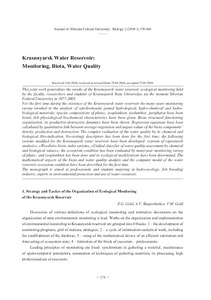Krasnoyarsk Water Reservoir: Monitoring, Biota, Water Quality(review)
Скачать файл:
URI (для ссылок/цитирований):
https://elib.sfu-kras.ru/handle/2311/786Автор:
Gold, Z.G.
Shaposhnikov, A.V.
Gold, V.M.
Ivanova, E.A.
Kojevnicova, N.N.
Glushenco, L.A.
Skoptseva, G.N.
Shulepina, S.P.
Popeltitskaya, I.M.
Sapozhnikov, V.A.
Morozova, I.I.
Enikeev, G. A.
Enikeeva, I. G.
Muchkina, E.Y.
Gladyshev, M.I.
Chuprov, S.M.
Gaevsky, N.A.
Olejnikov, B. V.
Raspopov, V.E.
Дата:
2008-09Аннотация:
This joint work generalizes the results of the Krasnoyarsk water reservoir ecological monitoring held by the faculty, researchers and students of Krasnoyarsk State Universityа (at the moment Siberian Federal University) in 1977-2005.
For the first time during the existence of the Krasnoyarsk water reservoir the many years monitoring survey resulted in the analysis of synchronously gained hydrological, hydro-chemical and hydro-biological materials; species compositions of phyto-, zooplankton, zoobenthos, periphyton have been listed; fish physiological biochemical characteristics have been given. Biota structural functioning organization, its productive-destructive dynamics have been shown. Regression equations have been calculated by quantitative link between average-vegetation and august values of the biota components’ density, production and destruction. The complex evaluation of the water quality by its chemical and biological (bio-indication, bio-testing) descriptors has been done for the first time; the following systems modified for the Krasnoyarsk water reservoir have been developed: «system of saprotaxob analysis», «Woodiviss biotic index system», «Unified classifier of water quality assessment by chemical and biological values»; the ecosystem condition has been evaluated by many-year monitoring survey of phyto-, and zooplankton has been done and its ecological modifications have been determined. The mathematical aspects of the biota and water quality analysis and the computer model of the water reservoir ecosystem condition have been described for the first time.
The monograph is aimed at professionals and students majoring in hydro-ecology, fish breeding industry, experts in environmental protection and use of water resources.

